A Few of Our Favorite Things
May 06, 2013

Eleven items are on display in this month's ad/blog. I'll start with the small pair of candlesticks and lead up to the exciting discovery about the sideboard. You may recognize these small French candlesticks from a previous ad. They make a return visit in this ad because they fit the composition better than some of our other sticks. These late 18th century taper sticks are only 3 3/4 inches tall with decorative machine turning patterns.
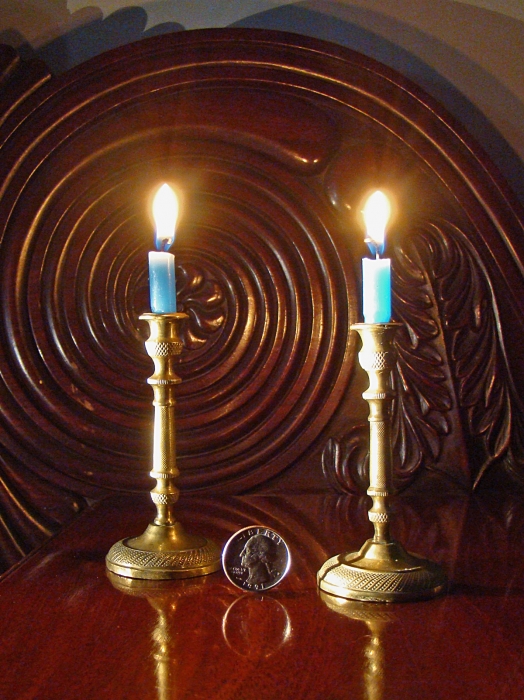
Pair French Taper Candlesticks
Holding the curtains are 19th century stamped brass English drapery tie backs with a woman's head in the center. They are a matched set of four and retain most of the original fire gilding.
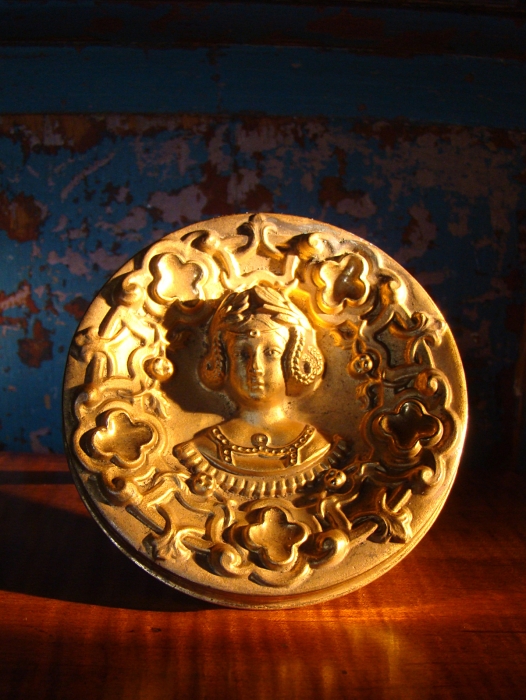
One of Four Matching Tie backs
Next is a pair of mid 18th century Battersea candlesticks of turned baluster form with painted enamel floral sprays over a white enamel ground. They have metal mounts, a scalloped hexafoil foot, and original removable bobeches.
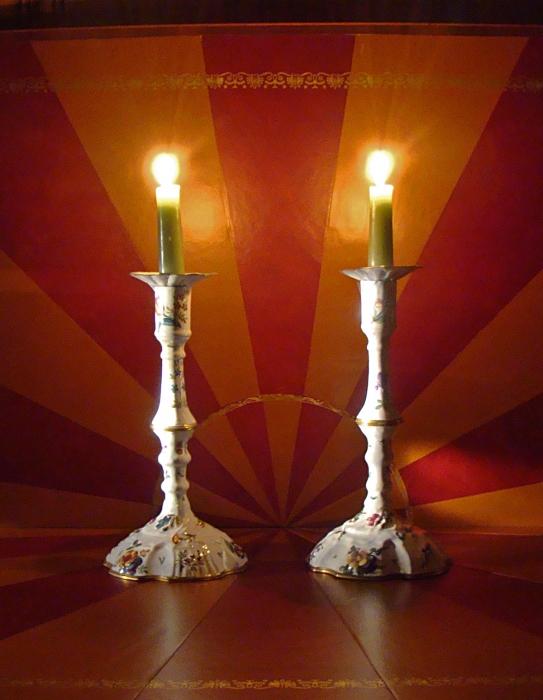
Pair of Battersea Candlesticks
Sir Theodore Janssen started an enameling factory in Battersea on the south bank of the Thames River at York House in London around 1750. The factory closed in 1756 but the craft and style continued in other areas such as Bliston and Birmingham.
On the wall hangs a gilded convex mirror and a pair of sconces. This mirror has already been sold but a similar one can be seen here. This type of convex mirror can be dated to around 1820 due to the small size and number of gilded balls arranged along the cove. If they were larger and fewer in number then the date would be later.
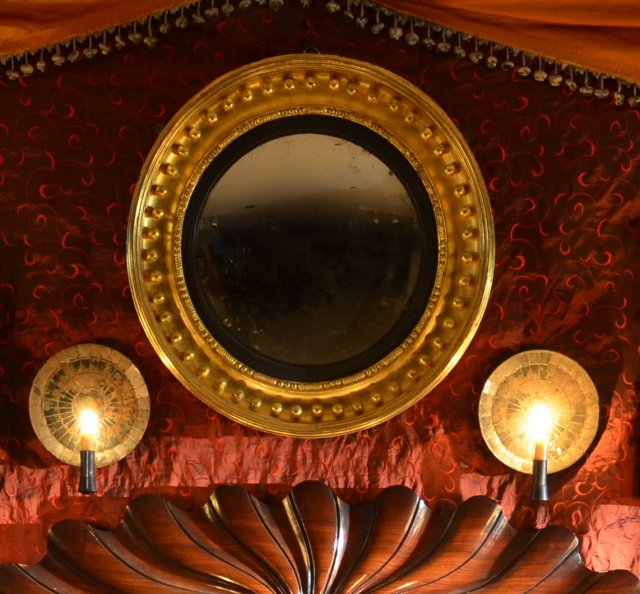 Pair of Sconces and Convex Mirror
Pair of Sconces and Convex Mirror
The pair of American mirror backed sconces date to the early 19th century. They are a small size at 7 3/4 inches in diameter and give off a warm shimmering light when lit at night. When put in the right position they also can create a cool pattern of light on the wall in the morning or afternoon when the sun is low in the sky.
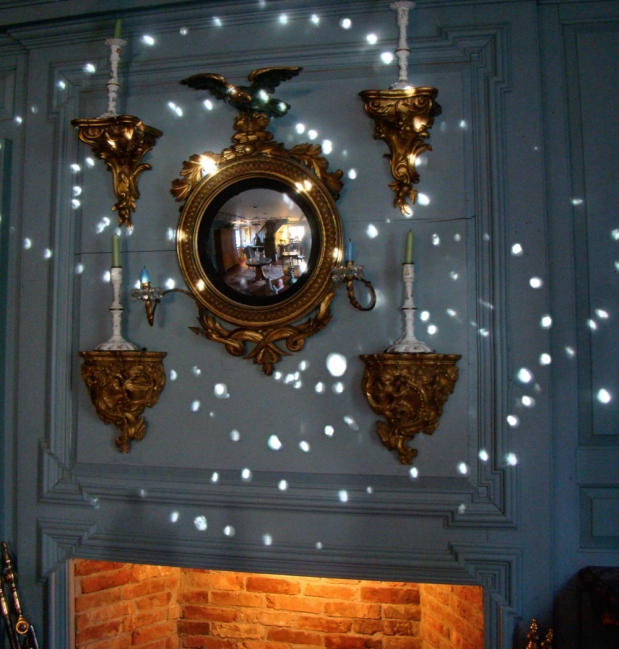 Mirrored Sconce Light Patterns
Mirrored Sconce Light Patterns
Meet Sir Walter Scott
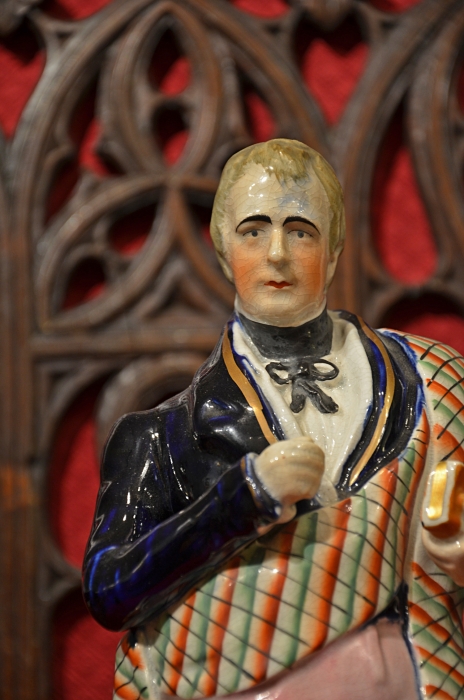
Sir Walter Scott
The center staffordshire figure is of Sir Walter Scott with his favorite deerhound Maida. Born in Edinburgh on August 15th 1771, Scott became a world famous poet, biographer, and Romantic novelist. It's interesting to note that he published his first translations and some 28 novels anonymously under 6 different aliases.
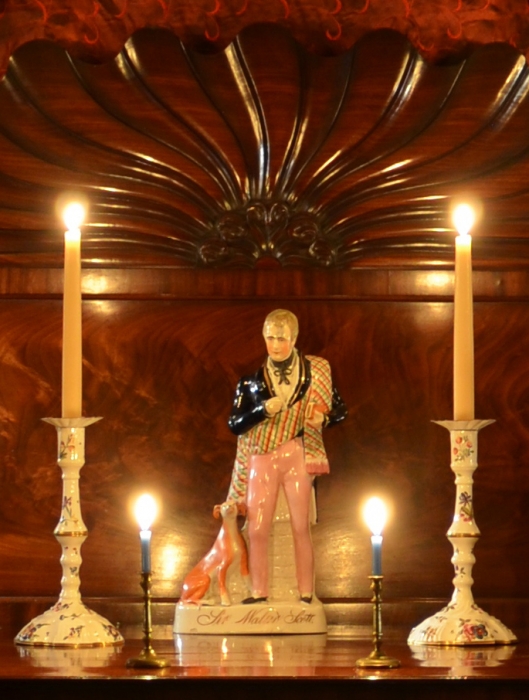
Sir Walter Scott
Flanking Sir Scott is a wonderful pair of early 19th century English Staffordshire standing lions. They have excellent painted faces, manes and unbroken arching tails. They stand proud on rectangular plinths of stepped faux marble with their outstretched paw grasping a globe representing the strength and reach of the British empire.
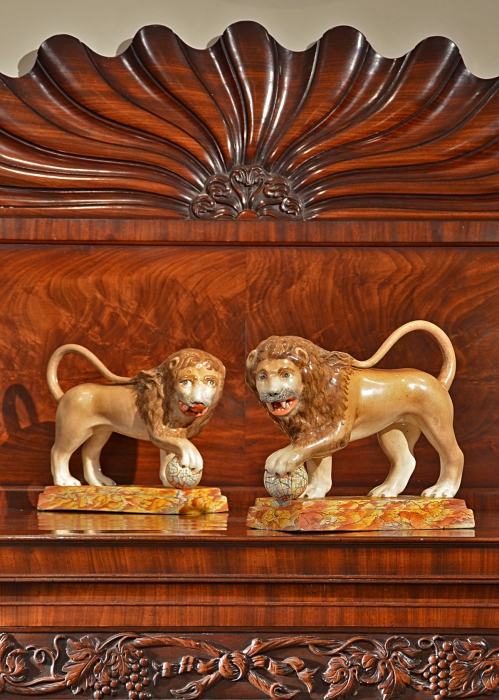
Pair of Staffordshire Lions
The aggressive posture of these lions is inspired by the famous Medici lions commissioned by Ferdinando I de'Medici the Grand Duke of Tuscany for the Villa Medici in Rome in the Late 16th century.
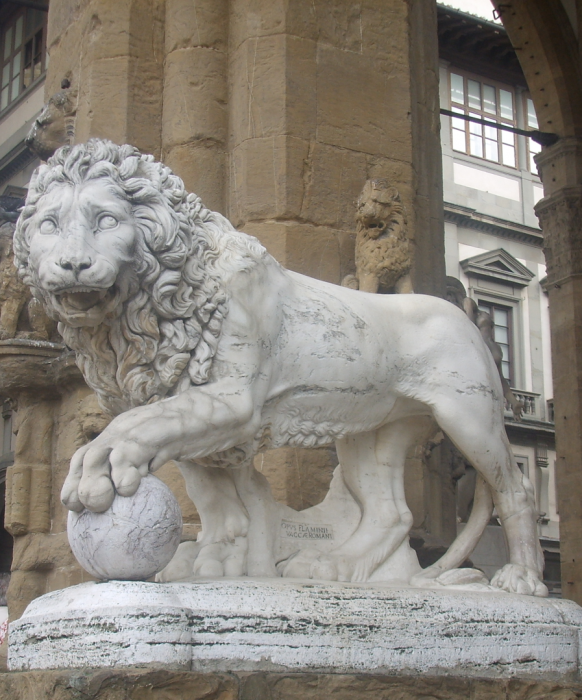
Vacca's Lion One of the Medici Lions
One of the Pair of Candelabras
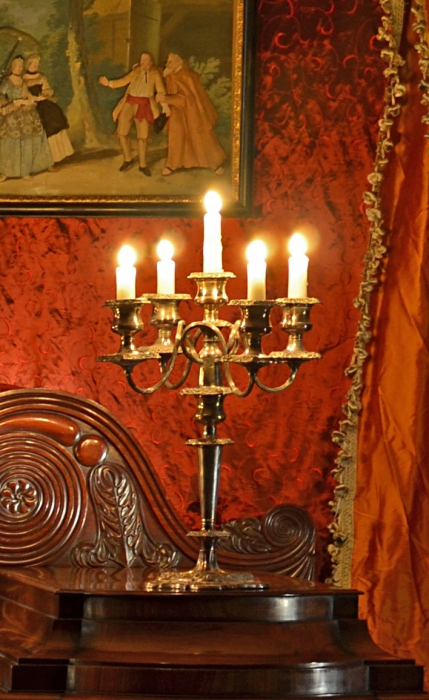
Silver plate Candelabra
The ornate pair of English Sheffield silver plate candelabra each have five candle sockets with double bobeches on removable spiral twist arms. They are early 20th century and stand 16 1/2 inches tall. For a closer look click here
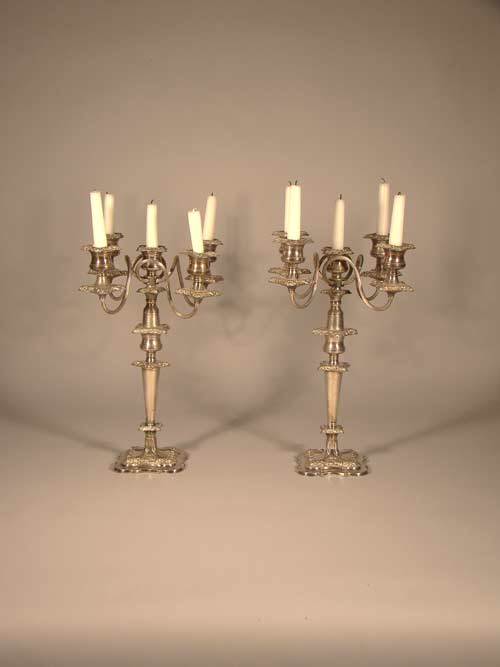
Pair of Candelabra
In the foreground sits an early Regency Anglo/Indian white marble urn. The boldly gadrooned top sits on a separate base.
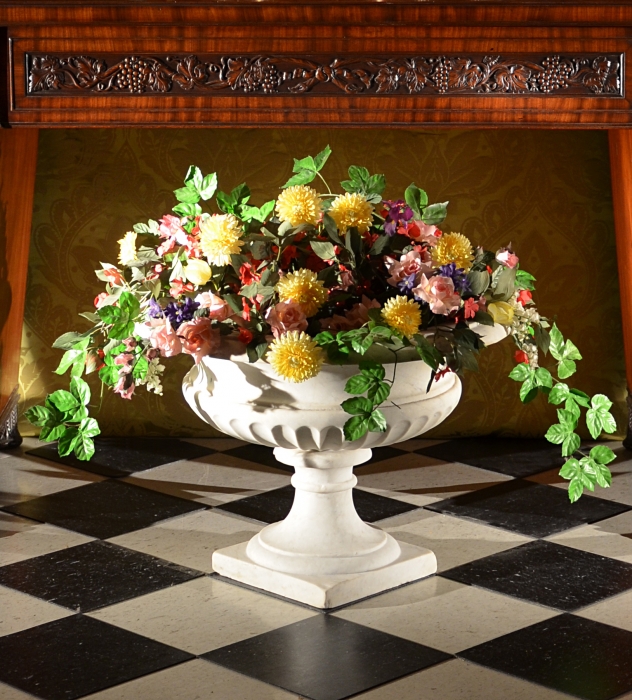 Regency Urn
Regency Urn
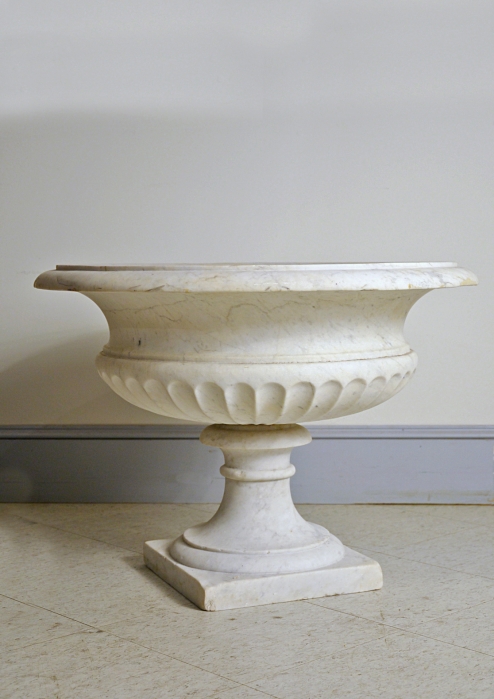
Anglo/Indian Urn
This brings us to the wonderful and rare pair of applique fabric panels or shadow boxes with fully formed figures in front of gouache painted pastoral scenes.
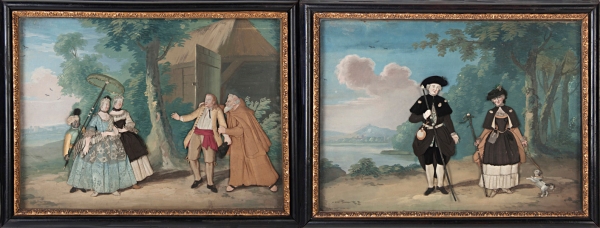
Late 18th Century Applique Fabric Shadow Boxes
In the first scene an important lady with her maid and parasol holding blackamoor encounter a suprised gentlemen and consoling monk in a brown robe. The women are dressed in their fine hooped petticoats. It is difficult to see how 3-D these figures are from a photo. Their bodies are made of thick paper, painted, and clothed in real quality fabrics.
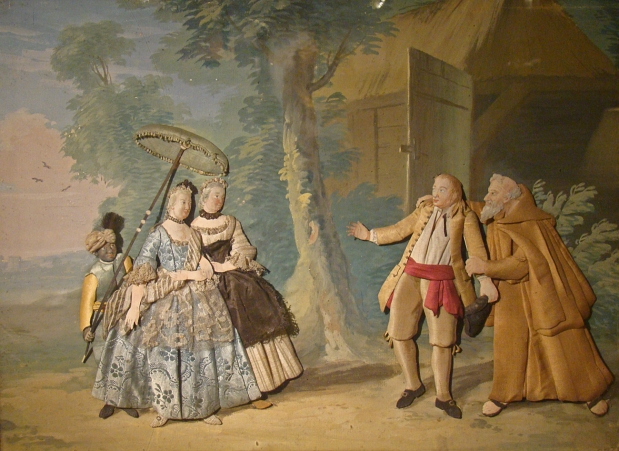 Applique 1
Applique 1
The second scene shows a well dressed man and woman out for a stroll down a country lane with their dog. They look prepared for a long walk carrying with them tall walking sticks and canteens.
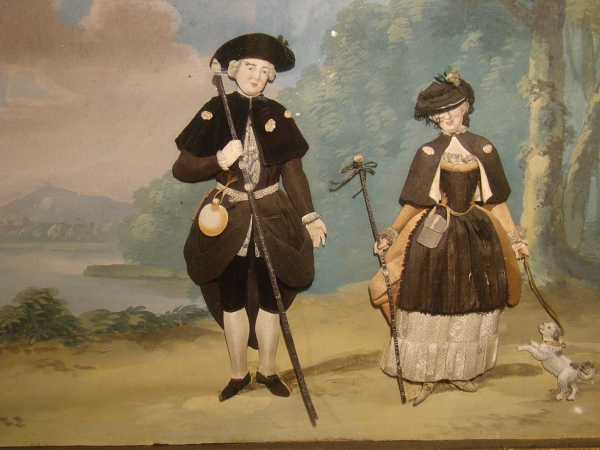
Applique 2
I have just started researching what these scenes are about but haven't had much luck. The age and the style of dress date to the late 18th century. The two works seem to go together perhaps interpreting a scene in a play or a part of a popular book of the day. If anybody has an idea of their origin or meaning please share in the comments at the end.
The Sideboard
I put this sideboard in my top ten favorite antiques that we have ever owned. The craftsmanship, quality of materials, condition, proportion, and bold design hit all the marks that we look for in an antique.
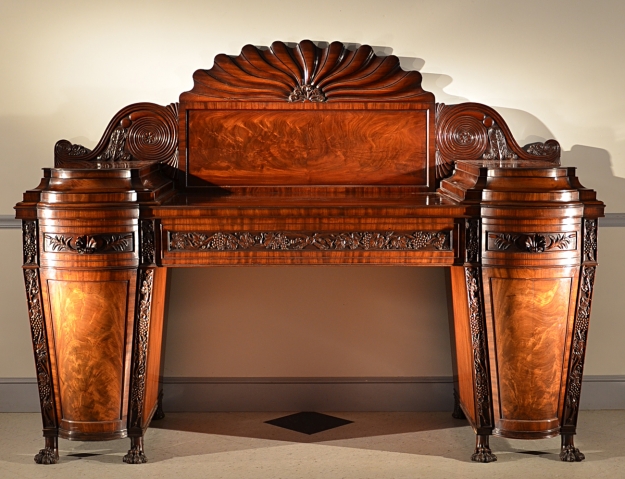 Scottish Sideboard
Scottish Sideboard
This sideboard has beautifully carved mahogany shell handles, grapevines, hairy paw feet, and sophisticated volutes on the backsplash. There is one large drawer between the two pedestals and two smaller drawers above the pedestal doors that open to plenty of storage. On the left is a shelf and two drawers. On the right is a large drawer with sections for storing open bottles. Under that are two baize lined sliding trays for unopened bottles.
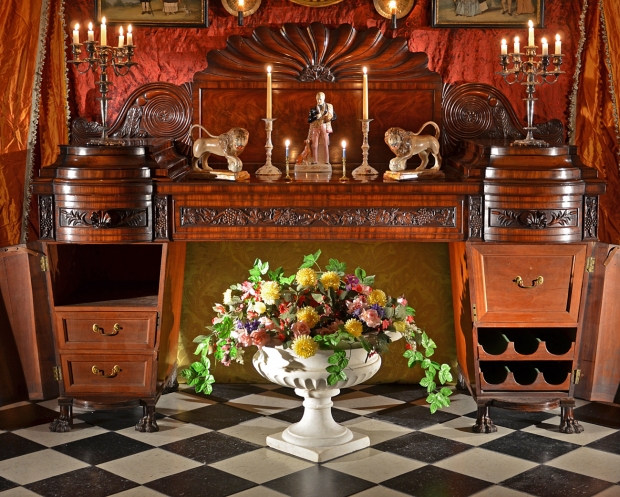 Scottish Sideboard Open
Scottish Sideboard Open
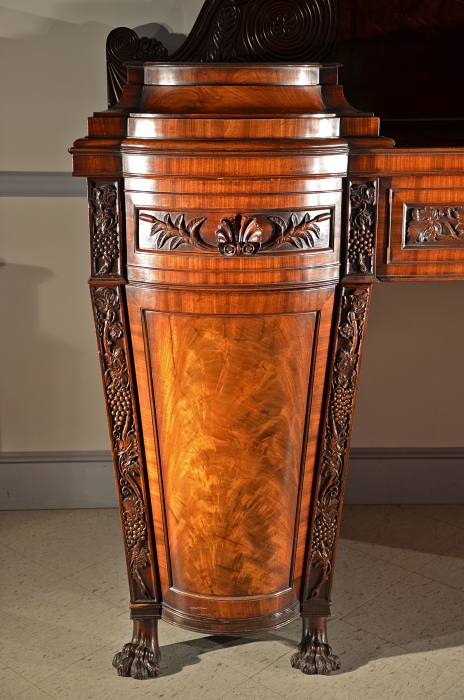
Detail of Grapevine Carving
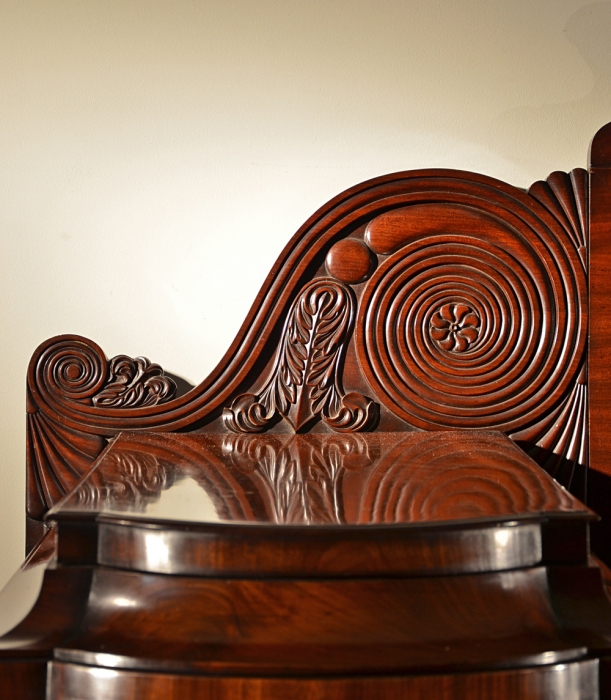 Detail of Carved Mahogany Volute
Detail of Carved Mahogany Volute
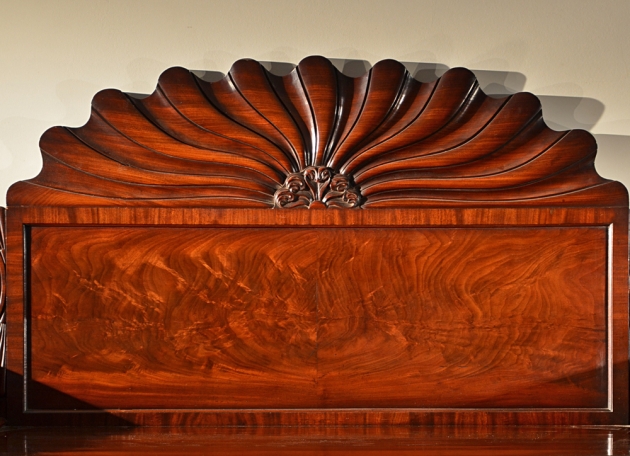 Stylized Mahogany Shell/Fan Backsplash
Stylized Mahogany Shell/Fan Backsplash
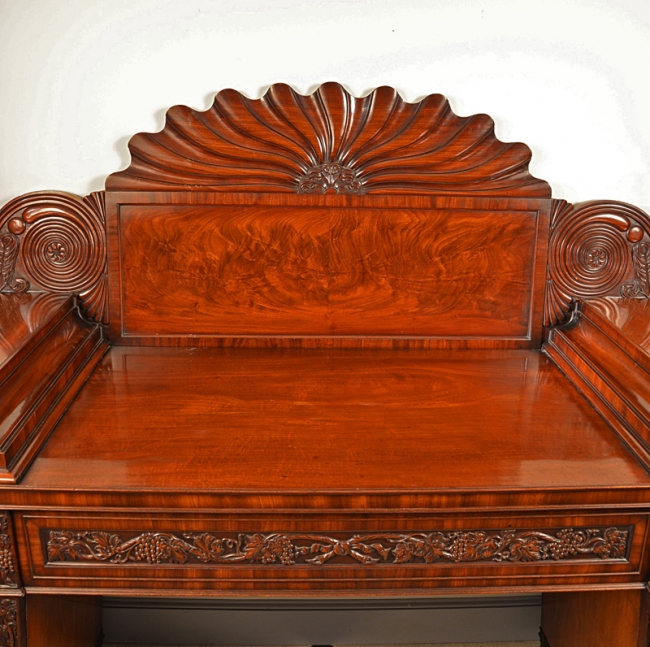 Sideboard Center Top and Back
Sideboard Center Top and Back
My Favorite Things Combined!
Probably my favorite thing to do in the antiques business is to look very closely and methodically at a piece of furniture. Close inspection can reveal not just construction methods but interesting clues and hidden marks. In doing this you feel more of a connection, not just to the piece, but the to the maker and past owners.
I had to move this sideboard for the ad photo. It is quite heavy so I took it apart to move it. With the center drawer out, off the pedestals, and on its side I could see under the top in the raking light a small whip of a fine pencil line faintly showing through the red wash.
So I decided to carefully take the sideboard apart.
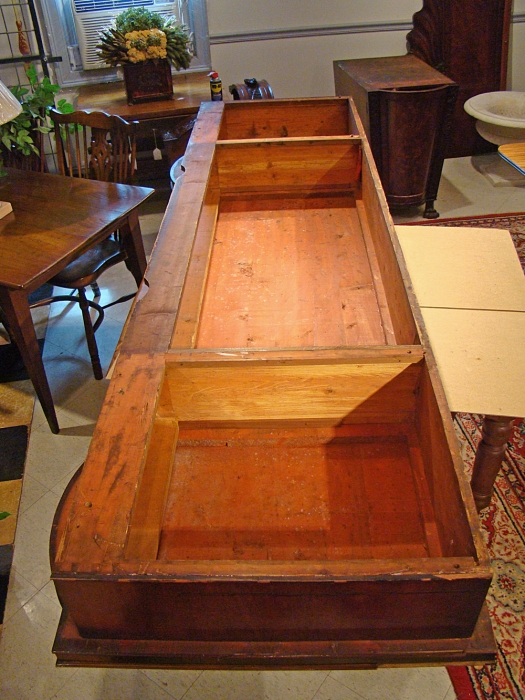
Sideboard Top Upside Down
It took about 2 1/2 hours to remove the 12 screws that hold the top two pieces together without stripping or breaking the screws.
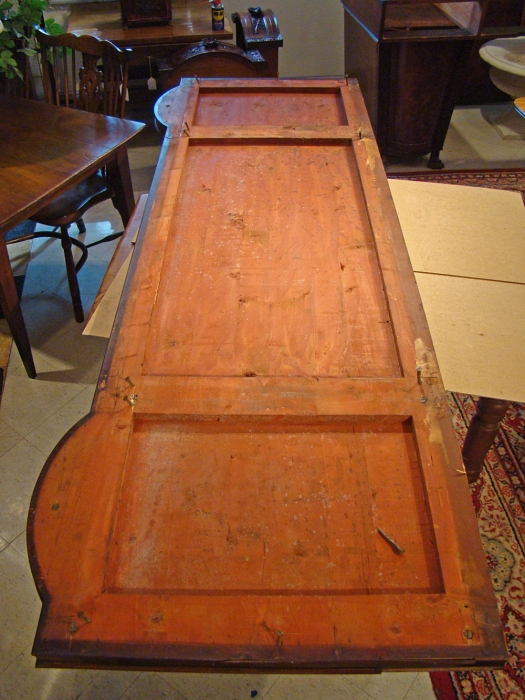
Drawer Frame Removed to Reveal Top
There is writing under the top, but so far I can't make sense of it. The next photo shows clear transfer film that I place over the writing to trace over without harming it.
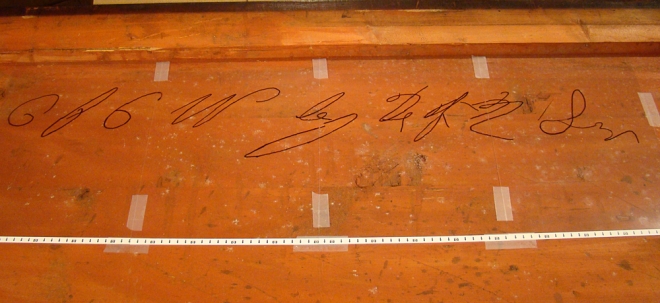 Some Writing Revealed
Some Writing Revealed
I've come this far, I might as well see if there's anything under the two pedestal caps. These are removed by unscrewing 10 more screws from the bottom. Here are photos of the pedestal caps after another 45 minutes of removing stubborn screws. Cool to see how they are made on the interior.
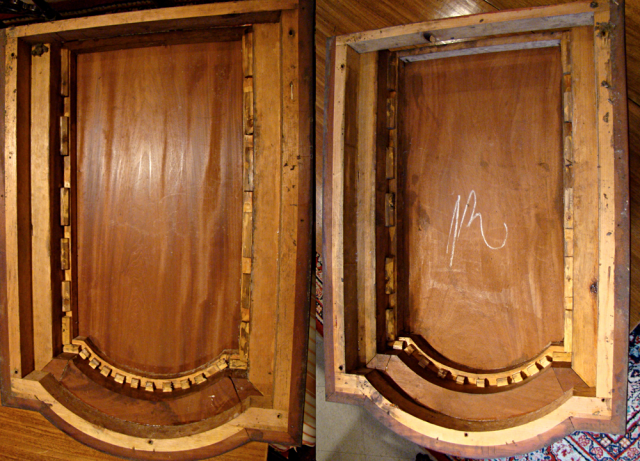 Under Pedestal Caps
Under Pedestal Caps
No writing under here except an R for right. I then flipped the top over and brushed away 200 years of dust build up. There staring me in my amazed face is not just a signature but a date as well. This was an awesome moment. Not only did I find hidden writing but I found it on one of my favorite pieces. The next three photos show it uncovered, in infrared, then on transfer film.
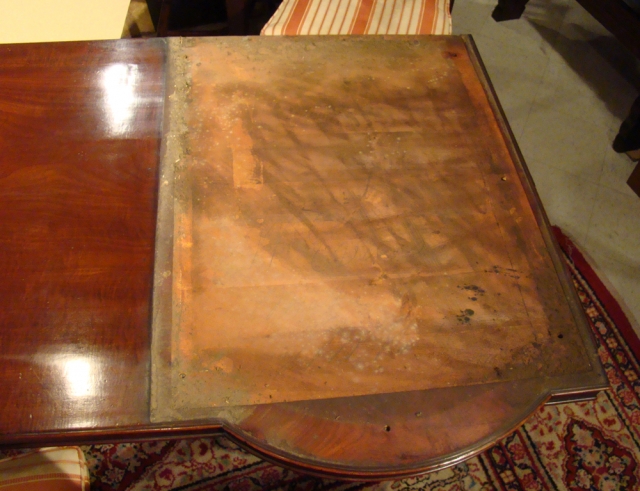 Eureka! Writing Found
Eureka! Writing Found
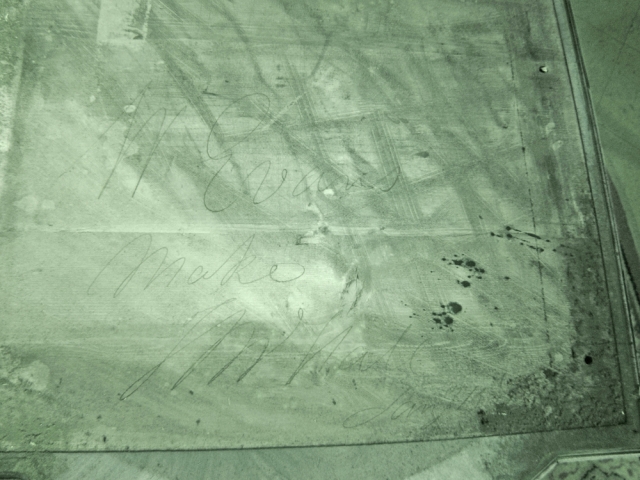 Infrared Photo of Writing
Infrared Photo of Writing
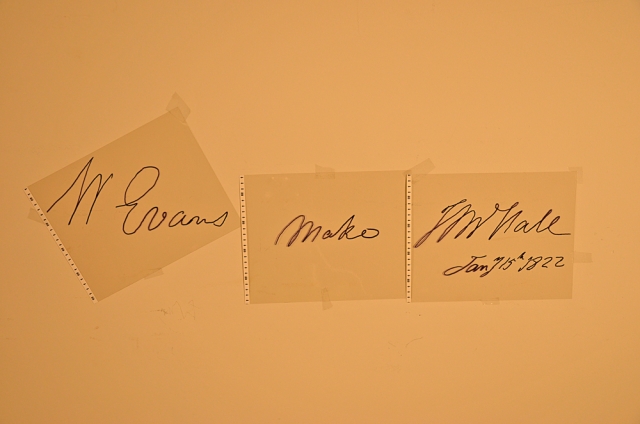 Transfer film copy of Hidden Writing
Transfer film copy of Hidden Writing
I read the signature as "W Evans make ?m ?ale Jan 15th 1822". Finding this is both exciting and frustrating. Who is the second name and what does the other writing say? The question marks could be a lot of different letters. It can be very tricky deciphering old handwriting. Does anyone have an opinion about either piece of writing? Try to decipher it yourself? Please comment below if you try.
There are a number of William Evans in England at this time including one in London who is recommended by Thomas Sheraton as a master cabinetmaker. However I am inclined to say that this sideboard is Scottish not English. There are no snap judgments when it comes to attributions.
The date is easy to read and important in showing what style was fashionable in 1822.
In our advertising and brand fueled world it's confusing to understand why so few antiques were signed, stamped, or labeled. It's also intriguing why someone would conceal their name and date. In some instances hidden writing was a form of communication with other craftsmen who might see it. To commemorate some change of location or partnership.
I mentioned above that Sir Walter Scott tried to be anonymous. Perhaps out of fun or to keep his name as a poet. In this case it's fun to think that W Evans was so proud of his work he had to author it. I can imagine that as the finished pieces were being assembled, and when no one was looking, he signed it and quickly screwed the pedestal cap down perhaps gleefully wondering if his mark would ever be found. 191 years later it has, hello Mr Evans.
The search begins to try and track down this hidden master. I'll update you if any new information comes to light.
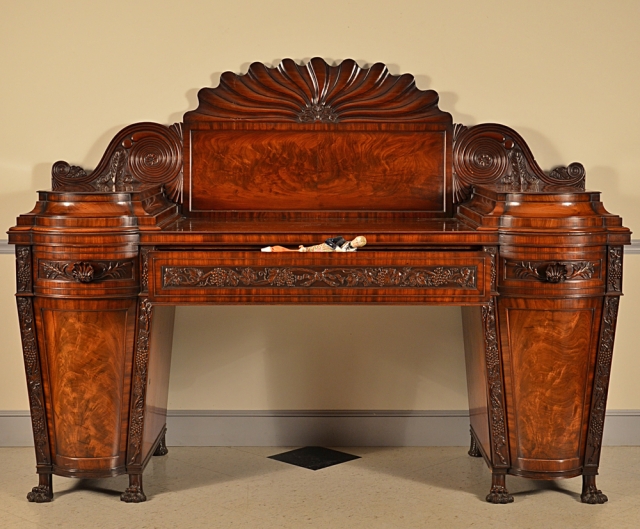 Sir Walter Scott "Time Rolls His Ceaseless Course"
Sir Walter Scott "Time Rolls His Ceaseless Course"
Stay in touch
Be the first to find out about new inventory and events.
Topics
Most Popular
- Welcome to Our Antiques Blog
- Antiques are about stories...our stories
- Volcanos in Art
- Venetian Mirrors : Adding elegance to your home
- Wax Portrait of Lord Nelson..."My backbone is shot through"
From the Archives
R. Joregensen Antiques offers one of New Englands largest collections of antiques just north of Boston in Wells, Maine. We are proud to be a member of the Antiques Dealers' Association of America, Maine Antiques Dealers Association, and the New Hampshire Antiques Dealer Association.
Copyright © R. Jorgensen Antiques. All rights reserved. | Website by Primal Media.






















Comments
Post new comment